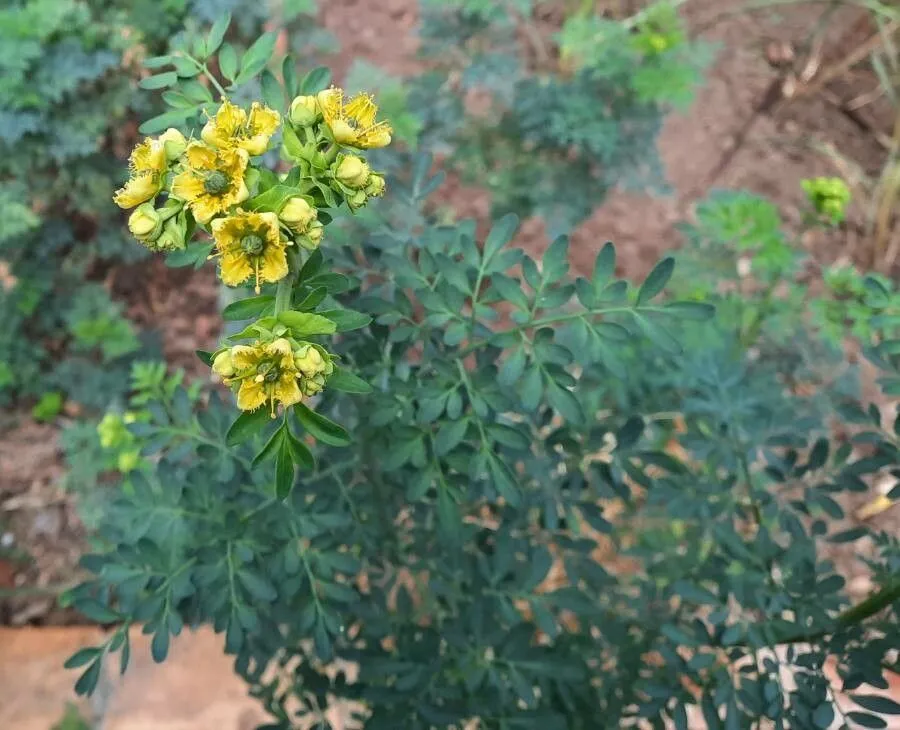
Author: L.
Bibliography: Mant. Pl.: 69 (1767)
Year: 1767
Status: accepted
Rank: species
Genus: Ruta
Vegetable: False
Observations: Macaronesia, Medit.
The Fringed Rue, scientifically known as Ruta chalepensis, is a notable species within the Ruta genus. First documented by Linnaeus in 1767, this plant is a member of the Rutaceae family, which is renowned for its medicinal and culinary contributions.
Typically found thriving in the regions of Macaronesia and the Mediterranean, the Fringed Rue displays a rich biological and cultural history. Its distinctive name, derived from the fringed appearance of its leaves, signifies one of its most identifiable features. The leaves are often finely divided and exude a fragrance when crushed, a characteristic trait shared by many members of the Rutaceae family.
Historically, Ruta chalepensis has been utilized for its medicinal properties, with various parts of the plant being used to create traditional remedies. The folklore surrounding this plant encompasses its reputed ability to ward off evil spirits and protect against contagions. These ancient uses highlight the plant’s integral role in local customs and herbal medicine practices.
In its natural habitat, the Fringed Rue flourishes in well-drained soils and locations that receive ample sunlight. It is commonly cultivated in gardens and natural reserves within the Mediterranean basin, adding a touch of greenery and aromatic quality to its surroundings. The plant’s adaptability allows it to contribute significantly to the biodiversity of these areas.
Moreover, beyond its practical applications, Ruta chalepensis also captures interest due to its ecological importance. As part of the dynamic Mediterranean ecosystem, it supports local wildlife, offering both shelter and nutrition to various insects and small animals.
In conclusion, the Fringed Rue, or Ruta chalepensis, is not just a plant of medicinal and cultural value but also one that contributes significantly to the ecological tapestry of the regions it inhabits. Its distinctive features and historic relevance make it a subject of interest in both botanical and cultural studies.
Eng: fringed rue
Swe: falsk vinruta
En: Fringed rue, Rue
Am: ጤና ኣዳም
Ar: سذاب حلبي
Ca: Ruda bracteosa
Nl: Franje-Wijnruit
Fi: Välimerenruuta
Fr: Rue de Chalep
De: Gefranste Raute
He: פיגם מצוי
It: Ruta d’Aleppo
Ml: അരൂത
Fa: راتا چلپنسیس
Pt: Arruda
Es: Ruda
Su: Inggu
Sv: Falsk vinruta
© copyright of the Board of Trustees of the Royal Botanic Gardens, Kew.
© copyright of the Board of Trustees of the Royal Botanic Gardens, Kew.
© copyright of the Board of Trustees of the Royal Botanic Gardens, Kew.
Taken Mar 7, 2022 by Hansjoerg Hageld (cc-by-sa)
Taken Dec 8, 2020 by Claudia Alejandra Bolívar (cc-by-sa)
Taken Mar 15, 2020 by Morales Jacobo (cc-by-sa)
Taken Mar 23, 2021 by sondire (cc-by-sa)
Taken May 28, 2018 by walter kern (cc-by-sa)
Taken Apr 28, 2017 by Tela Botanica − Liliane ROUBAUDI (cc-by-sa)
Taken Apr 28, 2017 by Tela Botanica − Liliane ROUBAUDI (cc-by-sa)
Taken Apr 28, 2017 by Tela Botanica − Liliane ROUBAUDI (cc-by-sa)
Taken May 10, 2016 by Tela Botanica − Liliane ROUBAUDI (cc-by-sa)
Taken Mar 11, 2022 by Miguel A. C. (cc-by-sa)
Taken Jan 5, 2022 by alessadro brign (cc-by-sa)
Taken Dec 10, 2020 by Ononis Katherine (cc-by-sa)
Taken Sep 17, 2022 by marce_lapacheco (cc-by-sa)
Taken Dec 8, 2020 by Claudia Alejandra Bolívar (cc-by-sa)
Taken Dec 22, 2021 by maria lopes (cc-by-sa)
Taken Apr 15, 2004 by Photoflora – Benoit BOCK (©)
Taken Dec 15, 2006 by Photoflora – Benoit BOCK (©)
Taken May 7, 2022 by Trap Hers (cc-by-sa)
Taken Apr 8, 2011 by Tela Botanica − Geneviève Botti (cc-by-sa)
Taken Oct 30, 2017 by Barbara Kozan (cc-by-sa)
Taken May 30, 2020 by Ирина (cc-by-sa)
Taken May 5, 2018 by bas yves (cc-by-sa)
Taken Nov 16, 2021 by montse batalle (cc-by-sa)
Taken Aug 6, 2021 by Bénédicte OUDART (cc-by-sa)
Taken Mar 27, 2022 by antonio maffei (cc-by-sa)
Taken Jun 19, 2020 by arciniegas viyuliceth (cc-by-sa)
Taken Mar 3, 2021 by Elizabeth Hattingh (cc-by-sa)
Taken May 21, 2022 by yuki mano (cc-by-sa)
Growth habit>: Subshrub, Forb/herb
Ph maximum: 8.0
Ph minimum: 7.5
Light: 8
Atmospheric humidity: 3
Bloom months: [‘may’, ‘jun’, ‘jul’]
Soil nutriments: 4
Family: Myrtaceae Author: (F.Muell.) K.D.Hill & L.A.S.Johnson Bibliography: Telopea 6: 402 (1995) Year: 1995 Status:…
Family: Rubiaceae Author: Pierre ex A.Froehner Bibliography: Notizbl. Bot. Gart. Berlin-Dahlem 1: 237 (1897) Year:…
Family: Sapindaceae Author: Koidz. Bibliography: J. Coll. Sci. Imp. Univ. Tokyo 32(1): 38 (1911) Year:…
Family: Asteraceae Author: A.Gray Bibliography: Pacif. Railr. Rep.: 107 (1857) Year: 1857 Status: accepted Rank:…
Family: Fabaceae Author: Medik. Bibliography: Vorles. Churpfälz. Phys.-Ökon. Ges. 2: 398 (1787) Year: 1787 Status:…
Family: Aspleniaceae Author: (Cav.) Alston Bibliography: Bull. Misc. Inform. Kew 1932: 309 (1932) Year: 1932…